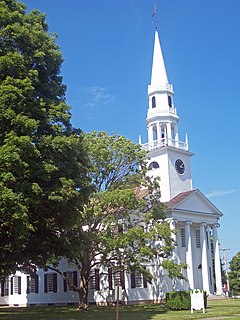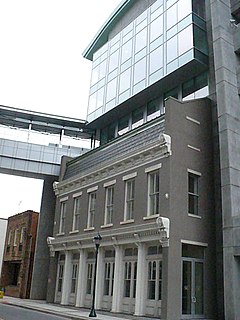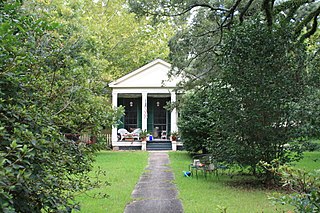
Litchfield Historic District, in Litchfield, Connecticut, is a National Historic Landmark District designated in 1968 as a notable and well-preserved example of a typical late 18th century New England village. As a National Historic Landmark, it is listed on the National Register of Historic Places (NRHP). It is the core area of a larger NRHP-listed historic district that includes the entire borough of Litchfield and was designated a state historic district in 1959.

The Prudence Crandall Museum is a historic house museum, sometimes called the Elisha Payne House for its previous owner. It is located on the southwest corner of the junction of Connecticut Routes 14 and 169, on the Canterbury, Connecticut village green. It is designated a U.S. National Historic Landmark as Prudence Crandall House.

The Harpswell Meetinghouse is a historic colonial meeting house on Maine State Route 123 in Harpswell, Maine. Built in 1757-59 to provide space for both religious services and town meetings, it is a little-altered and well-preserved example of a once-common form, and is the oldest such surviving building in the state of Maine. It was designated a National Historic Landmark in 1968.
Robinson House may refer to:

The Collins–Robinson House is a historic residence in Mobile, Alabama. It was built in 1843 in a Creole cottage style. It was placed on the National Register of Historic Places on October 18, 1984, as a part of the 19th Century Spring Hill Neighborhood Thematic Resource.

The Wade Askew House is a historic residence in Mobile, Alabama, United States. It was built in 1927 in the Spanish Colonial Revival style. The building was placed on the National Register of Historic Places on July 12, 1991. It is a part of the Spanish Revival Residences in Mobile Multiple Property Submission.

The Ernest Megginson House is a historic house located in Mobile, Alabama.

The George Fearn House is a historic residence in Mobile, Alabama, United States. It was built in 1904 in the Spanish Colonial Revival style by local architect George Bigelow Rogers. It was the first Spanish Colonial Revival building to be built in Mobile. The house was placed on the National Register of Historic Places on July 12, 1991. It is a part of the Spanish Revival Residences in Mobile Multiple Property Submission.

The Elisha Taylor House is a historic private house located at 59 Alfred Street in Midtown Detroit, Michigan, within the Brush Park district. The house was designated a Michigan State Historic Site in 1973 and listed on the National Register of Historic Places in 1975. Since 1981, it has served as a center for art and architectural study, known as the Art House.

The Coley Building was a historic two-story commercial building in Mobile, Alabama, United States. It began as a one-story Federal style masonry structure in 1836. It was the last 19th century building to survive on its city block. The block, situated between the streets of St. Francis, Royal, Water, and St. Michael, was a center for many of Mobile's brokerage firms prior to the American Civil War. The building was seized by the Confederate government during the war from a suspected Union collaborator. It was enlarged and remodeled in the 1870s, with the addition of a second floor and the application of a Beaux-Arts-influenced cast iron facade.

The Elisha KnightHomestead is a historic house at 170 Franklin Street in Stoneham, Massachusetts. Built c. 1750, it is the only property of that period in Stoneham that retains a rural setting. The two-story wood-frame house has relatively modest decorations; its decorated entry hood dates to a c. 1870 renovation that probably also removed a central chimney, replacing it with one at the east end.

The Amelia Stewart House, also known as the Carol O. Wilkinson House and William Hallett House, is a historic residence in Mobile, Alabama, United States. It was built in 1835 in the Greek Revival style. The house was placed on the National Register of Historic Places on May 29, 1992, based on its architectural significance.

The Ross Knox House is a historic Tudor Revival style residence in Mobile, Alabama, United States. The two-story brick and stucco house was completed in 1929. It is considered one of the best Tudor Revival houses in Mobile by the Alabama Historical Commission. Built in the 1920s upper-class suburb of County Club Estates, it was designed by architect John Platt Roberts.

The Robert L. Spotswood House, also known as the J. Clyde Glenn House, is a historic residence in Mobile, Alabama, United States. It was built in 1926 in the Spanish Colonial Revival style. The house was placed on the National Register of Historic Places on July 12, 1991, as a part of the Spanish Revival Residences in Mobile Multiple Property Submission.

The Carlowville Historic District is a historic district in the community of Carlowville, Alabama. The historic district covers 780 acres (320 ha) and is centered on Alabama State Route 89 and Dallas County roads 4, 47 and 417. It was placed on the National Register of Historic Places on January 18, 1978.

The Elisha Bushnell House is a historic house at 1445 Boston Post Road in Old Saybrook, Connecticut. With a construction history dating to 1678, it is one of Connecticut's oldest surviving buildings, exhibiting an evolutionary construction history. The house was listed on the National Register of Historic Places in 1978.

Robinson Springs United Methodist Church is a historic church in Millbrook, Alabama, USA. Built in 1848, it was added to the Alabama Register of Landmarks and Heritage in 1977 and the National Register of Historic Places in 1982.
There are 107 properties and historic districts on the National Register of Historic Places in Worcester, Massachusetts, west of I-190 and the north-south section of I-290 and north of Massachusetts Route 122, which are listed here. Two listings overlap into other parts of Worcester: one of the 1767 Milestones is located in eastern Worcester, and the Blackstone Canal Historic District traverses all three sections of the city.

The John Ash House, also known as Rowan House, Coker House and Rickles House, is a historic residence near Ashville, Alabama. John Ash emigrated from York County, South Carolina, first to Georgia, later settling in what is today St. Clair County, Alabama in 1817. Ash became a successful farmer, and served as a judge and member of the first Alabama State Senate. In 1821 Ash was one of five local leaders appointed to oversee the construction of a county courthouse and jail; the county seat was later named Ashville in his honor. Ash built a one-story dogtrot log house around 1820. In the 1830s, the house was extensively modified: three rooms and a second story were added to the house, and the exterior was covered with frame siding. The central dogtrot was filled in, and the main portion now resembled an I-house. A triangular pedimented gable adorns the front of the house, and each side has a brick chimney. A porch was added to the front of the house in the early 1900s. The house was listed on the Alabama Register of Landmarks and Heritage in 1990 and the National Register of Historic Places in 1991.

The Chambers–Robinson House is a historic house located at 910 Montgomery Avenue in Sheffield, Alabama.



















